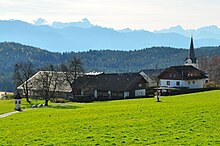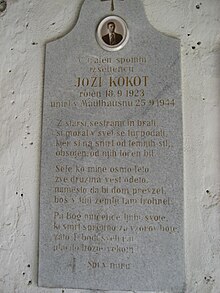Köstenberg
|
Köstenberg ( village ) locality cadastral community Köstenberg |
||
|---|---|---|
|
|
||
| Basic data | ||
| Pole. District , state | Villach-Land (VL), Carinthia | |
| Judicial district | Villach | |
| Pole. local community | Velden am Wörther See | |
| Coordinates | 46 ° 39 '5 " N , 14 ° 0' 38" E | |
| Residents of the village | 143 (January 1, 2020) | |
| Building status | 55 (2001) | |
| Area d. KG | 11.86 km² | |
| Statistical identification | ||
| Locality code | 02393 | |
| Cadastral parish number | 75308 | |
| Counting district / district | Köstenberg (20725 004) | |
| Source: STAT : index of places ; BEV : GEONAM ; KAGIS | ||
Köstenberg ( Slovenian : Kostanje ) is a cadastral municipality and a cluster of villages in the municipality of Velden am Wörthersee . It is located in the Ossiacher Tauern at an altitude of 790 m above sea level. A. and is mentioned in a document in 1150 in a list of Freising possessions . Until the municipal structural reform in 1973, Köstenberg was an independent municipality. The village had 150 inhabitants at the time of the 2001 census.
Parish Church of Saints Philip and Jacob
The sacred building was first mentioned in a document in 1202 and was last restored in 1962. The former Gothic fortified church stands on the edge of a rock step inside the fortified cemetery, the wall of which still shows three loopholes.
There are numerous Slovenian tombstones on the outer wall of the parish church. Some are from soldiers who died in the First World War, others remember the fate of the deceased with their poetic grave inscriptions. Jozi Kokot, who died on September 25, 1944 in Mauthausen , was given a special memorial in an epic poem that traces his fate and is thus a cultural and historical monument of local history.
Grazkogel
At the intersection of the former Köstenbergerstrasse and the old Römerstrasse, northwest of Oberjeserz, there is a ruin on the Grazkogel. It is mentioned in a document in 1353 as "turen und hof cze Chestnich". Around 150 cm high wall remains of a square tower as well as a 350 m long surrounding wall and parts of a second ring have been preserved on the Kogel.
Parasite forest
"Schmarotzwald" or "Hochwart" ( Slovenian : Hovart or Črni grad ) is a hamlet south of Köstenberg. The only point of interest of these houses in a clearing is the castle ruin Hochwart ( Slovene : Črni grad ), which can be reached after a 15-minute walk from the hamlet via a forest path.
Andrej Schuster-Drabosnjak and Slovenian cultural life
Andrej Schuster, commonly known as Drabosnjak (born May 6, 1768 in Drabosenig / Drabosinje, † December 22, 1825 in Umberg / Umbar) is one of the community's great sons. He was a farmer by profession, a folk dramatist, folk writer and poet by profession. He was a representative of the specific Slovene literary stream of Bukovništvo , which was carried by self-taught authors and which has its roots in the Slovene Protestant language culture. He wrote sacred folk plays that were copied, adapted and performed by amateur actors in the 19th, the first half of the 20th century and until today. The play by the prodigal son Izgubljeni sin and the shepherd or Christmas play Pastirska igra are famous . His pasijon , a passion play, was often performed as a popular theater with numerous amateur actors in the open air, including in Köstenberg / Kostanje.
The local Slovenian cultural association is named after him and is called Slovensko prosvetno društvo Drabosnjak na Kostanjah (Slovenian cultural association Drabosnjak in Köstenberg). This was founded in 1903 as a Slovenian educational association. Like all Slovenian educational associations of the time, special care was taken with language culture, singing and popular education. With Schuster-Drabosnjak, the tradition of folk drama was particularly present in Köstenberg.
The parish church Köstenberg / Kostanje, the branch churches Dröschitz / Trešiče, Kerschdorf / Črešnje, Oberdorf / Gornja vas are shown as bilingual.
Andrei Kokot
Andrej Kokot was a poet , translator and contemporary witness . His first collection of poems appeared in 1969 ( Zemlja molči ). Others followed: 1970 Ura vesti , 1972 Čujte, zvonovi pojo , 1974 Onemelo jutro . In his Kamen molka (1979) and Kaplje žgoče zavesti (1982) collections, he returned to traditional poetic forms. Kokot also wrote children's poems, for example Ringaraja 1983. Poems in German translation were published in 1978 under the title Die Totgeglaubten . A selection was made in the bilingual reference work on Slovenian literature in Carinthia by Reginald Vospernik u. a. published.
Andrej Kokot is also a contemporary witness. As a child, because he was a Slovene, he and his family were deported by the National Socialists to German camp detention on April 14, 1942. He published memories for the first time in 1996 (new edition 2012). His brother Jozi was murdered in Mauthausen concentration camp .
Drabosnjak at every turn
In Oberdorf / Gornja vas near Köstenberg there is a Drabosnjak monument.
In Oberjeserz / Zgornje Jezerce, a connecting road has been named A.-S.-Drabosnjak-Straße since 2012.
The Drabosnjak Museum ( Drabosnjakov dom ) is located in Köstenberg / Kostanje , a museum of everyday culture under the direction of the Slovenian Folklore Institute Urban Jarnik .
Leisure, culture and sport
- Starting point for hikes on the Ossiacher Tauern.
- Volksberglauf held annually in June. FROM LAKE TO MOUNTAIN - Tauernberglauf 2007
- Cycling opportunities in hilly terrain.
- An 18-hole course
- DSG Union Köstenberg - football and fitness
- Union LFL Köstenberg - Alpine skiing, Nordic skiing, fitness and motocross
- SPD Drabosnjak , Slovenian Cultural Association Drabosnjak, Köstenberg / Kostanje
- Drabosnjak Museum of Everyday Culture (Köstenberg / Kostanje) under the direction of the Slovenian Folklore Institute Urban Jarnik .
Personalities
- Andrej Schuster-Drabosnjak (1768–1825), Slovenian people's poet
- Andrej Kokot (1936–2012), Slovenian poet
literature
- H. Paulitsch: The phenomenon "bukovništvo" in the Carinthian-Slovenian cultural and literary history. Klagenfurt, Ljubljana, Vienna 1990.
- Reginald Vospernik, Pavle Zablatnik, Erik Prunč, Florjan Lipuš: The Slovenian word in Carinthia = Slovenska beseda na Koroškem. Vienna 1985, Bukovniki pp. 90–97, text examples by Andrej Kokot in both national languages pp. 428–503
- J. Lesjak: 75 let po ustanovitvi Slovenskega prosvetnega društva za Kostanje in okolico (1903–1978). Klagenfurt / Celovec 1978.
- V. Hazler, P. Sketelj, U. Sereinig: Etnološki muzej Kostanje, Kraj spomina in učenja, Vodnik = Museum of Everyday History in Köstenberg, ed. by Slovensko Prosvetno Društvo Drabosnjak / Slovenian Cultural Association SPD Drabosnjak, Krščanska Kulturna Zveza / Christian Cultural Association, Slovenska Prosvetna Zveza / Slovenian Cultural Association, Slovenski Narodopisni Inštitut Urban Jarnik / Slovenia. Folklore Institute Urban Jarnik. Köstenberg / Kostanje 2002.
Web links
Individual evidence
- ↑ Pavel Zdovc Slovenska krajevna imena na Koroškem Avstrijskem = Slovenian place names in Carinthia. Extended Edition. Ljubljana 2010. ISSN 0560-2920 .
- ^ H. Paulitsch: The phenomenon "bukovništvo" in the Carinthian-Slovenian cultural and literary history. Klagenfurt, Ljubljana, Vienna 1990.
- ↑ Pavle Zablatnik : Bukovniki - folk poets . In: R. Vospernik, Pavle Zablatnik, Erik Prunč, Florjan Lipuš: The Slovenian word in Carinthia = Slovenska beseda na Koroškem. Vienna 1985, pp. 90-97.
- ^ Marija Mitrović: History of Slovene Literature. From the beginnings to the present , Klagenfurt [ea] 2001, pp. 110–118. ISBN 3-85013-834-8
- ↑ Suster-Drabosnjak, Andrej Kokot, Magdalena (ed.): Pasijon. (... Carinthian Passion Play ...). Celovec / Klagenfurt, Trst 1983
- ↑ Bukovniki . In: Enciklopedija Slovenije, Volume 1, Ljubljana 1991, p. 406; Andrej Šuster . In: Enciklopedija Slovenije, Volume 13, Ljubljana 1991, p. 167.
- ↑ Pavle Zablatnik : Bukovniki - folk poets . In: Reginald Vospernik, Pavle Zablatnik, Erik Prunč, Florjan Lipuš: The Slovenian word in Carinthia = Slovenska beseda na Koroškem. Vienna 1985, pp. 90-97. ISBN 3-215-04304-1
- ^ J. Lesjak: 75 let po ustanovitvi Slovenskega prosvetnega društva za Kostanje in okolico (1903–1978). Klagenfurt / Celovec 1978.
- ↑ List of parishes in the Rosegg / Rožek deanery
- ^ Andrej Kokot ( Memento from July 27, 2010 in the Internet Archive ) Biography, Austrian Society for Literature; Archive version of July 27, 2010
- ↑ Andrej Kokot . In: Enciklopedija Slovenije, Volume 5, Ljubljana 1991, p. 191.
- ^ Reginald Vospernik , Pavle Zablatnik , Erik Prunč , Florjan Lipuš : The Slovenian word in Carinthia = Slovenska beseda na Koroškem. Vienna 1985, pp. 482-503.
- ↑ B. Entner, A. Malle (eds.): Pregon koroških Slovencev 1942, The expulsion of the Carinthian Slovenes. Klagenfurt / Celovec 2012
- ↑ Johannes W. Schaschl (ed.): When Carinthia deported his own children, The Expulsion of the Carinthian Slovenes 1942-1945, Historical Overview - Tales of Contemporary Witnesses - Letters and Documents. Klagenfurt / Celovec 2012. ISBN 9783708606736
- ↑ B. Entner, H. Wilscher: "All Slovenes!" Carinthian Slovenes between disenfranchisement and discrimination. In: Verena Pawlowsky, Harald Wendelin [ed.]: Excluded and disenfranchised. Robbery and return. Austria from 1938 until today. Vienna 2006, 54–76.
- ^ Andrej Kokot: The child that I was, memories of the expulsion of the Slovenes from Carinthia ; Andrej Kokot: Ko zori spomin…: otroška doživetja v pregnanstvu , Celovec / Klagenfurt 1996, 2012.
- ↑ Reginald Vospernik: Driven from home twice - The Carinthian Slovenes between 1919 and 1945 - A family saga, Klagenfurt / Celovec, 2011.
- ↑ http://www.kleindenkmaeler.at/detail/drabosnjak_gedenkstein
- ↑ http://www.ethno.at/
- ↑ http://www.kkz.at/drustva_skupine/C16







